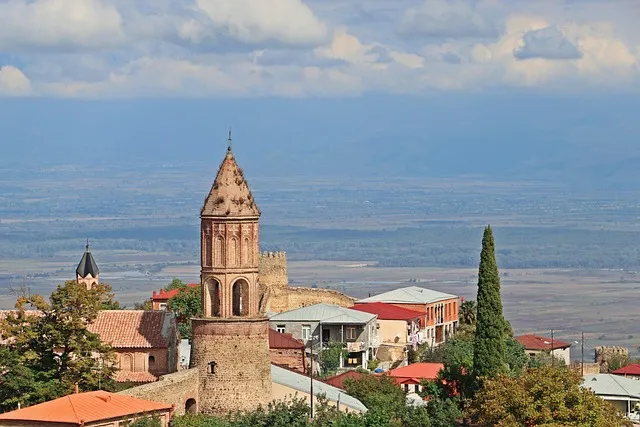Georgia's history is vividly represented through its diverse historical landmarks, including ancient indigenous sites, colonial forts, Civil War battlefields, and architectural wonders like the Georgia State Capitol. These sites reflect the state's rich cultural narrative and the resilience of its people. The Okefenokee Swamp preserves the natural beauty that existed before European settlement, while antebellum mansions and 19th-century architecture offer insights into a refined past. Georgia's commitment to preserving these landmarks ensures their continued significance and allows visitors to experience history firsthand. The Antebellum homes, with their Greek Revival and Federal styles, embody the wealth and social status of the pre-Civil War South. Preservation acts and offices like the Georgia Historic Preservation Office support the maintenance of these sites, balancing the need for historical preservation with modern development. Georgia's historical attractions, combined with its traditional Southern hospitality, form a key part of the state's identity, influencing contemporary design and societal norms while celebrating a living heritage that honors tradition and embraces innovation.
Explore the rich tapestry of Georgia’s history through its well-preserved landmarks, each telling a unique story of a bygone era. From the grandeur of Antebellum homes that stand as silent sentinels to the past, to the ongoing efforts in preservation led by state initiatives, Georgia’s historical treasures and embodiment of Southern elegance are a testament to its cultural heritage and architectural legacy. This article will take readers on a journey through these historic sites, highlighting their significance in maintaining a connection with the state’s storied past, while also showcasing the vibrancy of Southern charm in contemporary Georgia. Join us as we traverse the annals of history, one landmark at a time.
- Georgia's Historical Landmarks: A Journey Through Time
- The Architectural Grandeur of Antebellum Homes
- Preservation Efforts and the Role of State Initiatives
- Southern Charm and Heritage in Modern Georgia
Georgia's Historical Landmarks: A Journey Through Time

Georgia’s landscape is rich with historical landmarks that offer a window into the state’s diverse history, from indigenous cultures to colonial settlements, and through the Civil War and Reconstruction periods. These landmarks stand as testaments to the resilience and ingenuity of their builders and the cultural narratives they represent. The Georgia State Capitol, for instance, with its imposing dome and classical revival architecture, reflects a bygone era of governance and political discourse. It is a symbol of state pride and a working monument to democracy. Another gem is the Okefenokee Swamp, an expansive wilderness area that has remained relatively untouched for centuries, offering a glimpse into the natural environment that existed in the Southeast before European settlement. These landmarks are not merely historical sites; they are living entities that continue to shape and influence contemporary Georgia, enriching its identity as a state with a deep-rooted history and a legacy of southern elegance. The preservation of these treasures ensures that visitors can experience a tangible connection to the past, fostering an appreciation for the historical richness that continues to define the Peach State. From the antebellum mansions along the Ocmulgee River to the Civil War battlefields and the 19th-century architecture in cities like Savannah and Atlanta, Georgia’s historic treasures invite travelers to embark on a journey through time, immersing themselves in the stories of those who came before.
The Architectural Grandeur of Antebellum Homes

In the heart of the American South, the architectural legacy of Antebellum homes stands as a testament to the region’s storied past. These grandiose abodes, with their columns, galleries, and elaborate woodwork, embody the aesthetic of Southern elegance and sophistication. Constructed predominantly between 1780 and 1860, they were not merely residences but symbols of wealth, power, and social status. The Greek Revival and Federal styles are particularly well-represented, with white columns reminiscent of ancient Greece and symmetrical facades that reflect the ideals of neoclassicism. The interiors boast soaring ceilings, intricate mahogany paneling, and fireplaces of marble and stone, all designed to impress and to provide comfort to the planters and their families who lived there. In Georgia, specifically, these homes are a reflection of the state’s unique blend of history, culture, and natural beauty, with many having been meticulously preserved and others thoughtfully restored, offering visitors a glimpse into the lives of those who came before and the grandeur of Southern living at its finest.
Preservation Efforts and the Role of State Initiatives

Georgia’s historic treasures stand as a testament to the region’s rich heritage, with preservation efforts playing a pivotal role in maintaining their integrity. State initiatives have been instrumental in safeguarding these architectural and cultural landmarks against the ravages of time and modernization. The Georgia Historic Preservation Act serves as a cornerstone for these endeavors, providing a framework for the identification, evaluation, registration, protection, and nomination of properties to the National Register of Historic Places. This legislation not only protects the tangible elements of history but also seeks to preserve the stories and traditions associated with these sites. The Georgia State Historic Preservation Office further supports these efforts by offering grants and technical assistance to communities and property owners, fostering a collaborative approach that respects both the past and the potential for sustainable future use. These concerted actions ensure that the state’s architectural heritage, from antebellum mansions to Victorian homes, continues to contribute to Georgia’s identity and cultural narrative.
Southern Charm and Heritage in Modern Georgia

Georgia’s historic treasures and southern elegance are not relics confined to the past; they are alive and integral to the modern identity of the state. The architectural grandeur that defines many of Georgia’s antebellum homes, with their columned porches and intricate woodwork, continues to inspire contemporary design. These structures serve as tangible reminders of the region’s storied past, while also reflecting a commitment to preservation and a reverence for tradition. The hospitality and gracious living that characterize southern charm are woven into the social fabric, influencing modern customs and manners, and shaping the state’s cultural ethos. In cities like Savannah, where historic squares are flanked by Spanish moss-draped oaks, the legacy of Southern elegance is preserved through meticulous restoration efforts and celebrated during events that draw visitors from around the globe. This harmonious blend of old and new ensures that Georgia’s rich heritage remains a living tapestry, continually evolving yet ever mindful of its storied origins.
Georgia’s legacy is etched into its historic treasures and embodied in the enduring elegance of its Southern heritage. From the storied landmarks that offer a window into our collective past to the meticulously preserved Antebellum homes standing as monuments to craftsmanship and history, these sites serve as testaments to Georgia’s resilient and evolving narrative. The state’s preservation efforts are a clear indication of the value placed on maintaining this rich tapestry of history for future generations. As modern Georgia continues to evolve, its Southern charm remains a constant, weaving threads of tradition into contemporary life, ensuring that the essence of its heritage not only endures but also flourishes.
